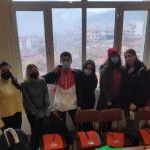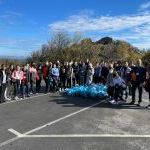Greener Together, Greener for our Planet
This project makes students aware of the environmental problems created by humans that lead to negative long-term impacts on our planet. The students become responsible citizens that contribute to leaving a clean and safe world for future generations. The participating schools became environmentally-friendly schools that implemented environmental policies. The project aims to become a model for our communities and encourage other schools to take measures in the area of ecology.
Website
Greener Together, Greener for our Planet website
Country
Media
Useful links:
The UK government has produced a paper on top tips for sustainability in schools
The United Nations has developed a range of student resources to help learning around sustainable development goals
* TOP TIP *
'Work with the children to identify how they can take small-scale action to build a cleaner future'
How is the project linked to climate change and sustainability?
The five main topics relating to a healthy planet were included in the project:
• Water is Life - exploring water as a source of life, and the issues of water shortage
• Keep our environment clean - looking at recycling and waste management
• Breathe and Let Breathe - highlighting issues around air pollution and air quality
• Global warming issues and renewable energy for sustainable development.
• Taking action to build a cleaner future.
Who is involved?
The project was mainly aimed at students, who were involved within all the different stages of the project – preparation, exchanges and activities. The target group of students is made of 1,000 pupils aged 14-16 that constitute a mixture of different nationalities, economic and social backgrounds, rural and urban areas, students of mixed abilities (high and low achievers), different religions, and vocational training students. The project was very appealing as all participants observed and learned from each other in terms of problems, career paths, interests and opportunities. Out of these students, 100 students were chosen to participate directly in the exchanges.
The project involved the following people:
• Vocational education and training students.
• Teachers
• NGOs
• Local municipalities
How are the participants involved?
In order for students to be prepared for exchanges, they carried out research, interviews with schoolmates, parents and acquaintances about the environmental issues addressed. Students were encouraged to talk to the local authorities and the local NGOs to find out about local and national policies and how schools could be involved. All these findings were shared with partners during the exchanges, which involved activities and presentations created by students for students, as well as teacher-coordinated activities to work on topic-related STEM projects. In the case of taking action for a cleaner future, students carried out and shared campaigns on environmental awareness.
Key steps:
The project adopted the following techniques to help deliver an inclusive and transformative project. You may wish to include these ideals in your own projects:
• Exchange good ideas and practices with other European countries regarding environmental issues
• Familiarise the students with different environmental issues and with concepts like sustainable development and renewable energy sources
• Raise students’ autonomy and self-learning by carrying out research, gathering and presenting data
• Foster students’ creativity, analytical thinking and critical thinking
• Enhance students’ self-confidence with regard to new environments, to promote their flexibility and adaptability
• Promote the development of the participants’ intercultural competence and the awareness of shared European values
• Improve communication, social and interpersonal skills in a multicultural context
• Promote social inclusion in terms of students facing all types of difficulties
• Empower and encourage students to become involved in the life of their communities
• Foster teachers’ development by means communication and practice sharing with their European peers


